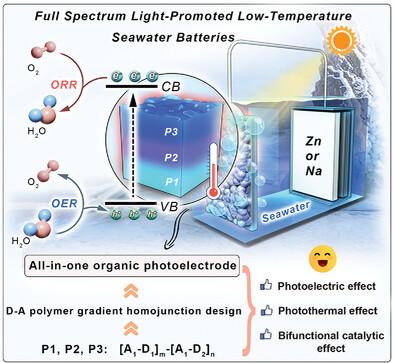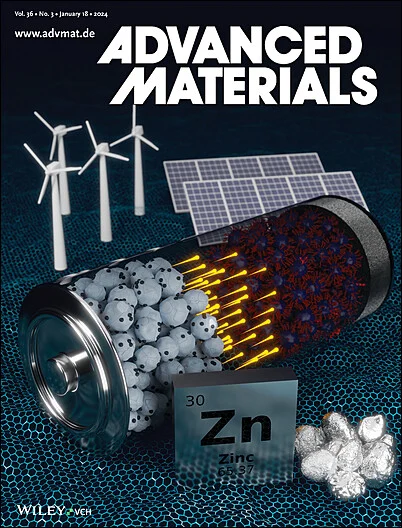Organic Gradient Homojunction via D-A Engineering Enables Photoelectric/Photothermal Dual-Assisted Catalysis Toward Full Spectrum Light-Coupled Low-Temperature Seawater Batteries
IF 27.4
1区 材料科学
Q1 CHEMISTRY, MULTIDISCIPLINARY
引用次数: 0
Abstract
Coupling solar into metal-air batteries represents an appealing paradigm for storing intermittent solar energy and boosting device energy efficiency. Current solar-coupled metal-air systems rely on UV or visible light harvesting and suffer from inferior charge separation ability and limited solar utilization. Additionally, sunlight action behavior/mechanism in some useful scenarios (seawater electrolytes, low-temperature) is underexplored. Herein, through gradient homojunction design via donor-acceptor (D-A) engineering, it exploits a novel full-spectrum-responsive polymer homojunction photoelectrode (PGH) for sunlight-coupled seawater-electrolyte-based Zn/Na-air batteries (Zn-SWAB/Na-SWAB) with boosted sunlight utilization and energy efficiency at lower temperatures. By stacking three pre-designed analogous [A1-D1]m-[A1-D2]n copolymers with gradient energy-levels and rich heterocycles, PGH integrates separate metal-free active sites for oxygen reduction/evolution reaction (ORR/OER), efficient photothermal effect with full-spectrum-absorption, and superior photoelectric effect with high charge-separation efficiency. Thus, PGH under simulated-sunlight produces remarkably-enhanced photocurrent up to 3.2 and 21.4 times during ORR/OER in near-neutral electrolytes. This endows sunlight-coupled PGH-enabled Zn-SWAB and Na-SWAB with low voltage gaps of 0.08/0.25 V at room temperature, and 0.21/0.43 V at 0 °C – both of which surpass most reported room-temperature results. Their energy efficiencies (84.6%/86.8%) at 0 °C even approach their room-temperature counterparts (93.9%/92.3%). Mechanistic studies reveal photoelectric/photothermal dual-promoted bidirectional oxygen catalysis responsible for intriguing performance.

求助全文
约1分钟内获得全文
求助全文
来源期刊

Advanced Materials
工程技术-材料科学:综合
CiteScore
43.00
自引率
4.10%
发文量
2182
审稿时长
2 months
期刊介绍:
Advanced Materials, one of the world's most prestigious journals and the foundation of the Advanced portfolio, is the home of choice for best-in-class materials science for more than 30 years. Following this fast-growing and interdisciplinary field, we are considering and publishing the most important discoveries on any and all materials from materials scientists, chemists, physicists, engineers as well as health and life scientists and bringing you the latest results and trends in modern materials-related research every week.
 求助内容:
求助内容: 应助结果提醒方式:
应助结果提醒方式:


